Adjusting the pressure switch for a hydraulic accumulator: instructions on setting up equipment + expert advice
To ensure that the water pressure in the autonomous water supply (heating) system remains stable, a special device is installed in it - a hydraulic accumulator. At the same time, an integral part of this unit is a very small device - a pressure switch.
If the latter is not configured correctly, the hydraulic accumulator will constantly turn on and off unnecessarily. As a result, we will get excessive energy consumption and rapid wear of pumping equipment.
Agree, by installing a hydraulic accumulator at home, we want to increase the efficiency of the water supply system and the stability of its operation. However, if the adjustment of the pressure switch is carried out with errors, then the task will not be achieved. It is extremely important to set up this small device accurately and according to the rules. Moreover, it needs to be adjusted both during initial installation and later, during continuous operation.
The content of the article:
Operating principle of a pressure switch
An autonomous water supply system in a private house consists of water pipes, a pump and control and cleaning elements. The hydraulic accumulator in it plays the role of a water pressure control device. First, the latter is stored in the battery, and then, as needed, it is consumed when the taps are opened.
This configuration of the water supply reduces operating time pumping station, as well as the number of its “on/off” cycles.
The pressure switch here performs the function of controlling the pump. It monitors the filling level hydraulic accumulator water, so that when this tank is empty, turn on the pumping of liquid from the water intake in time.
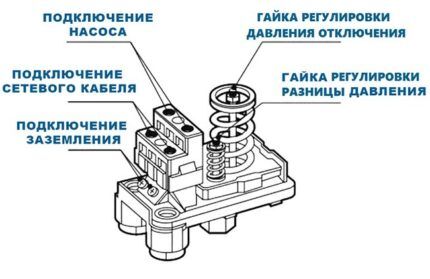
If the water pressure in the system is within the parameters set on the relay, the pump does not work. If the pressure drops below the minimum setting Pstart (Pmin, Rvkl), then electric current is supplied to the pumping station to make it work.
Then, when the hydraulic accumulator is filled to Pstop (Pmax, Poff), the pump is de-energized and turned off.
The relay considered step by step works as follows:
- There is no water in the accumulator. The pressure is below Pstart - set by a large spring, the membrane in the relay moves and closes the electrical contacts.
- Water begins to flow into the system. When Pstop is reached, the difference between the upper and lower pressures is set by a small spring, the membrane moves and opens the contacts. As a result, the pump stops working.
- Someone in the house opens the tap or turns on the washing machine - the pressure in the water supply decreases. Then, at some point, there is too little water in the system, and the pressure again reaches Rstart. And the pump turns on again for pumping.
Without a pressure switch, all these manipulations with turning the pumping station on/off would have to be done manually.

When choosing the pressure switch in question, first of all you should look at:
- maximum temperature of the working environment - for hot water supply and heating there are their own sensors, for cold water supply their own;
- pressure adjustment range - possible settings Pstop and Pstart must correspond to your specific system;
- maximum operating current - pump power should not be higher than this parameter.
Settings the relay in question pressure is made based on calculations taking into account the capacity of the accumulator, the average one-time water consumption by consumers in the house and the maximum possible pressure in the system.
The larger the battery and the greater the difference between Rstop and Rstart, the less often the pump will turn on.
First step before setup
The pressure switch is adjusted during initial installation and then, if certain problems arise in the plumbing system.
In the second case, before you start setting up the relay unit, you need to establish the cause of the problem. Perhaps the problem is not at all with the device in question; there is no need to touch it.
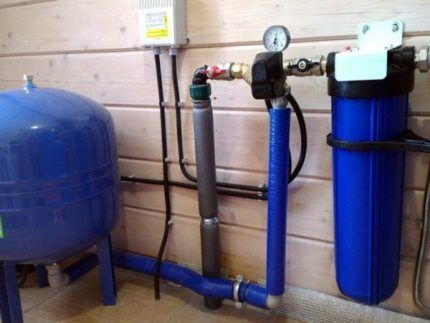
The second extremely important point is water purification. The accumulator and relay have a rubber membrane. If sand gets into the pipes, this rubber will deteriorate (crack) and will no longer hold pressure. IN hydraulic accumulator system Cleaning filters must be present.
If the pressure in the water supply according to the pressure gauge has reached Pstop, but the pump continues to work, then the problem usually lies in clogged pipes and/or filters. It is also possible to have the voltage supply contacts to the pumping station go to the relay.In the first case, you need to get rid of sand and scale in the system, and in the second, check the contact group and 220 V wiring.
It is also possible that the water from the pipes in the house is completely drained, but the pump does not want to turn on. Here, first of all, we check the power supply.
If there is voltage in the network, the wiring and contacts are working properly, then “9 out of 10” the pressure switch has failed. It will have to be replaced with a new one; it is almost impossible to somehow repair this device.
Step-by-step adjustment instructions
Conventional plumbing gaskets are rated at 6 bar, with a maximum and short-term capacity of up to 10 bar. A working pressure in water supply systems and heating of residential buildings in most cases fluctuates between 2–3.5 bar.
You should not set the Rstop relay above 4 bar. Most household models of this device on the market have a maximum Pstop of 5 bar. However, setting this parameter to the maximum of “five” is not recommended.
Do not overtighten or loosen the springs on the device until they stop; this may lead to its incorrect operation. It is necessary to leave a small margin for tension/loosening.
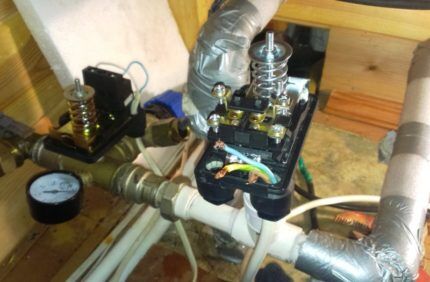
Large spring - setting the pressure to start the pump. Small spring - setting the pressure difference to turn off the pumping station.
The accumulator relay is configured as follows:
- Water is drained from the water supply. Then the working pressure in the bulb with air is set in the hydraulic accumulator - 10% less than the planned start-up.
- The power to the relay is turned on and the pump starts working.The pressure gauge is used to record the pressure when it turns off (Pstop).
- The faucet in the sink opens a little with a small trickle. The pressure is recorded when the pump is turned on again (Rstart).
To increase the Rstart value, tighten the large spring clockwise. To increase the difference between Rstart and Rstop, tighten the small spring.
These settings are reduced by loosening the springs counterclockwise.
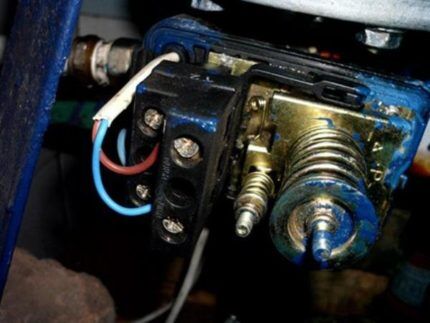
After setting the required Rstart and Rstop, the relay with the pump is connected to the network. If everything works as it should according to the pressure gauge, then the setup is complete. Otherwise, the above three steps are repeated again.
Advice from experienced specialists
It is recommended to connect the accumulator pressure switch to the electrical panel of the house via a separate line with its own RCD.
It is also imperative to ground this sensor; for this there are special terminals on it.
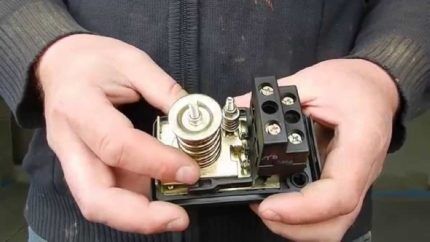
If water is visible on the body or inside the relay, the device should be immediately disconnected from power. The appearance of moisture is a direct sign of a rupture of the rubber membrane. Such a unit must be immediately replaced; it cannot be repaired or continued to be used.
Cleaning filters must be installed in the system. It’s impossible without them. However, they need to be cleaned regularly.
Also, once every quarter or six months the pressure switch itself should be washed. To do this, unscrew the lid on the device with the inlet pipe at the bottom. Next, the opened cavity and the membrane located there are washed.
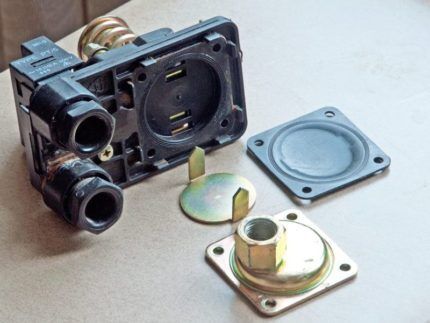
The pressure switch should be checked for correct operation and general serviceability once every 3–6 months. At the same time, the air pressure in the accumulator is also checked.
If, during adjustment, sharp jumps in the needle on the pressure gauge occur, then this is a direct sign of a breakdown of the relay, pump or hydraulic accumulator. It is necessary to turn off the entire system and begin a full check of it.
Conclusions and useful video on the topic
How to properly configure the pressure switch:
In simple words about pressure switches for hydraulic storage tanks:
How to adjust the pressure switch in a pumping station:
Without a properly functioning and correctly configured pressure switch, the hydraulic accumulator turns into an unnecessary piece of hardware. Adjustment of the device in question, at first glance, looks extremely simple - only two springs that need to be tightened/loosened. However, setting up this device has its own nuances. If you make mistakes during adjustment, then instead of being useful, the hydraulic accumulator can only bring problems.
If you have personal experience in setting up a pressure switch or have any questions, please write in the comments block below. Our experts will definitely help you understand the selection and configuration of this device to maximize the efficiency of your water supply or heating system.




The pressure switch does not turn off
Most likely, the pipe through which pressure enters the relay is clogged.
But there may be other reasons, for example, burnt terminals, mechanical damage to the relay.
Good evening, the hydraulic accumulator automatic switches out if I don’t use water.
There is an error in the description of the pressure switch setting algorithm. In point 1, the air pressure in the accumulator should be 10% less than Rstart (the water pressure at which the pump starts). This, with justification, can be seen in the videos provided on the site. Please correct this, as this is an unforgivable mistake for the website engineering-en.techinfus.com. People will do just that.
Hello! Thanks for the mentioned error! Corrected!
Hello. I would like to know why, when the pressure decreases, water suddenly leaves the hydraulic tank and when the pump is turned on, water fills the system with air pockets and water comes out of the taps intermittently.
Hello. This is the problem we have. The hydraulic accumulator has gained a pressure of 2 atmospheres and water does not flow from the tap. In short, the pressure is not released. I pumped 1.5 atmospheres into the hydraulic accumulators in the tank as required.
Hello! The pressure switch on the accumulator cannot be adjusted to turn off and turns off at 3.8 bar, what could be the reason?
Good afternoon. I installed a drain valve in the working water supply system (supplying water from a well to the house) (through a tee in a pipe in the well below the freezing level but not more than 2 meters from ground level).When the pump was disconnected from the network and the water was completely drained from the tap (close to the hydraulic accumulator) and the hydraulic accumulator as well, the water began to leave the drain valve. When this valve was unscrewed, the remaining water in the system began to come out of this installation location under decent pressure, i.e. Apparently even the valve did not work due to this pressure. What does this mean and how can I resolve the issue? Could there be too much pressure in the accumulator? Or something else?
When the pressure in the crab drops to 1 ATM, the well pump turns on, pumps up to 3.2 ATM, the pump turns off, the pressure immediately drops to 1 ATM and the pump turns on almost immediately. Those. The pump constantly turns on and off. The crab has a capacity of 50 liters, and about 10 liters of water are collected in it